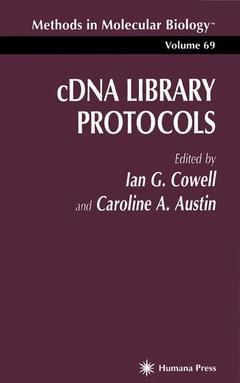Description
cDNA Library Protocols, Softcover reprint of the original 1st ed. 1997
Methods in Molecular Biology Series, Vol. 69
Language: English
Subjects for cDNA Library Protocols:
321 p.
· 15.2x22.9 cm
· Paperback
Description
/li>Contents
/li>
The first libraries of complementary DNA (cDNA) clones were con structed in the mid-to-late 1970s using RNA-dependent DNA polymerase (reverse transcriptase) to convert poly A* mRNA into double-stranded cDNA suitable for insertion into prokaryotic vectors. Since then cDNA technology has become a fundamental tool for the molecular biologist and at the same time some very significant advances have occurred in the methods for con structing and screening cDNA libraries. It is not the aim of cDNA Library Protocols to give a comprehensive review of all cDNA library-based methodologies; instead we present a series of up-to-date protocols that together should give a good grounding of proce dures associated with the construction and use of cDNA libraries. In deciding what to include, we endeavored to combine up-to-date versions of some of the most widely used protocols with some very usefiil newer techniques. cDNA Library Protocols should therefore be especially useful to the investigator who is new to the use of cDNA libraries, but should also be of value to the more experienced worker. Chapters 1?5 concentrate on cDNA library construction and manipula tion, Chapters 6 and 7 describe means of cloning difficult-to-obtain ends of cDNAs, Chapters 8-18 give various approaches to the screening of cDNA libraries, and the remaining chapters present methods of analysis of cDNA clones including details of how to analyze cDNA sequence data and how to make use of the wealth of cDNA data emerging from the human genome project.
cDNA Library Construction from Small Amounts of RNA Using Paramagnetic Beads and PCR.- Increasing the Average Abundance of Low-Abundance cDNAs by Ordered Subdivision of cDNA Populations.- Isolation of Messenger RNA from Plant Tissues.- cDNA Library Construction for the Lambda ZAP®-Based Vectors.- Clone Excision Methods for the Lambda ZAP®-Based Vectors.- Using Rapid Amplification of cDNA Ends (RACE) to Obtain Full-Length cDNAs.- Inverse PCR Approach to Cloning cDNA Ends.- Cloning Gene Family Members Using the Polymerase Chain Reaction with Degenerate Oligonucleotide Primers.- Subtractive Hybridization for the Isolation of Differentially Expressed Genes Using Magnetic Beads.- Preparation of Competent Cells for High-Efficiency Plasmid Transformation of Escherichia coli.- The Tetramethylammonium Chloride (TMAC) Method for Screening cDNA Libraries with Highly Degenerate Oligonucleotide Probes Obtained by Reverse Translation of Amino Acid Sequences.- Screening cDNA Libraries by Hybridization with Double-Stranded DNA Probes and Oligonucleotides.- Immunological Screening of ?-Phage cDNA Expression Libraries.- Cloning Sequence-Specific DNA-Binding Factors from cDNA Expression Libraries Using Oligonucleotide Binding Site Probes.- Protein Interaction Cloning by Far-Western Screening of ?-Phage cDNA Expression Libraries.- Yeast Two-Hybrid Library Screening.- Signal Sequence Trap.- Isolation of Genetic Suppressor Elements (GSEs) from Random Fragment cDNA Libraries in Retroviral Vectors.- Expression and Preparation of Fusion Proteins from Recombinant ?gt1.1 Phages.- Computer Analysis of Cloned Sequences.- The TIGR Human cDNA Database.- Searching the dbEST Database.- Reference cDNA Library Facilities Available from European Sources.
© 2024 LAVOISIER S.A.S.




